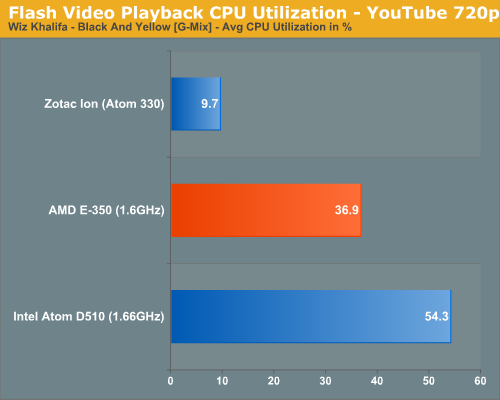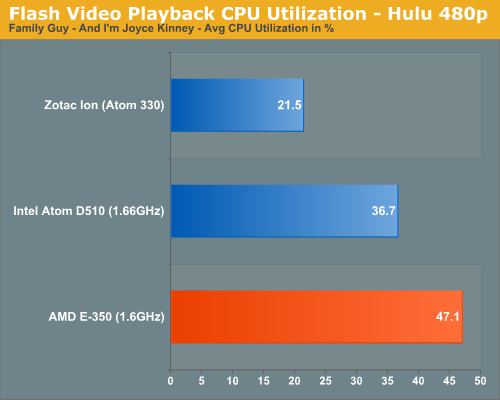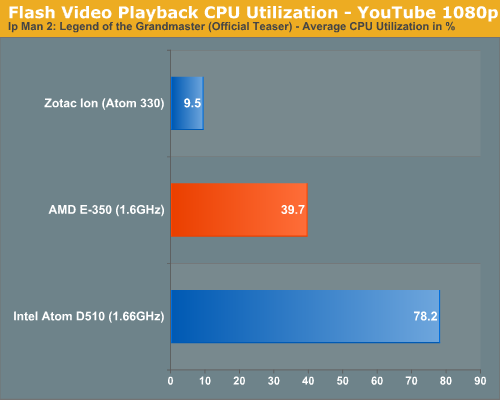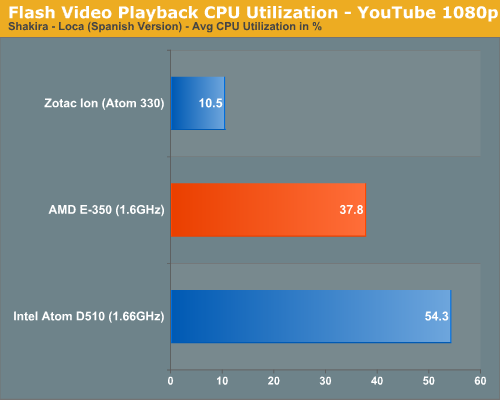The Brazos Review: AMD's E-350 Supplants ION for mini-ITX
by Anand Lal Shimpi on January 27, 2011 6:08 PM ESTBlu-ray & Flash Video Acceleration
Compatibility is obviously a strongpoint of Brazos. So long as what you’re decoding can be hardware accelerated you’re pretty much in the clear. But what about CPU utilization while playing back these hardware accelerated formats? The CPU still needs to feed data to the GPU, how many cycles are used in the process?
I fired up a few H.264/x264 tests to kick off the investigation. First we have a 1080p H.264 Blu-ray rip of Quantum of Solace, averaging around 15Mbps:
| Quantum of Solace 1080p H.264 CPU Utilization (1:00 - 1:30) | |||||
| Platform | Min | Avg | Max | ||
| AMD E-350 | 22.7% | 27.8% | 35.3% | ||
| Intel Atom D510 | Fail | ||||
| Zotac ION | 14.6% | 17.2% | 20.1% | ||
A standard Atom platform can’t decode the video but ION manages a 17% average CPU utilization with an Atom 330. Remember that the Atom 330 is a dual-core CPU with SMT (4-threads total) so you’re actually getting 17.2% of four hardware threads used, but 34.4% of two cores. The E-350 by comparison leaves 27.8% of its two cores in use during this test. Both systems have more than enough horsepower left over to do other things.
Next up is an actual Blu-ray disc (Casino Royale) but stripped of its DRM using AnyDVD HD and played back from a folder on the SSD:
| Casino Royale BD (no DRM) CPU Utilization (49:00 - 49:30) | |||||
| Platform | Min | Avg | Max | ||
| AMD E-350 | 28.1% | 33.0% | 38.4% | ||
| Intel Atom D510 | Fail | ||||
| Zotac ION | 17.7% | 22.5% | 27.5% | ||
Average CPU utilization here for the E-350 was 33% of two cores.
Finally I ran a full blown Blu-ray disc (Star Trek) bitstreaming TrueHD on the E-350 to give you an idea of what worst case scenario CPU utilization would be like on Brazos:
| Star Trek BD CPU Utilization (2:30 - 3:30) | |||||
| Platform | Min | Avg | Max | ||
| AMD E-350 | 29.0% | 40.1% | 57.1% | ||
At 40% CPU utilization on average there’s enough headroom to do something else while watching a high bitrate 1080p movie on Brazos. The GPU based video decode acceleration does work, however the limits here are clear. Brazos isn’t going to fare well as a platform you use for heavy multitasking while decoding video, even if the video decode is hardware accelerated. As a value/entry-level platform I doubt this needs much more explanation.
Now let’s talk about Flash.
I ran through a number of Flash video tests at both YouTube and Hulu ranging in resolution from 480p all the way up to 1080p. I used Flash 10.1, 10.2 beta as well as an unreleased version of 10.2 beta provided by AMD.


For the most part GPU accelerated Flash video does work well. Performance under both YouTube and Hulu was flawless, provided that I wasn’t watching 1080p content. Watching 1080p content in YouTube wasn’t entirely smooth on Brazos, despite posting very reasonable CPU utilization numbers.


I took my concerns to AMD and was told that this was a known issue with Brazos and Flash 10.1 and that 10.2 should alleviate the issue. AMD then supplied me with an unreleased version of Flash 10.2 to allow me to verify its claims. While 1080p playback improved with AMD’s 10.2 beta, it wasn’t perfect (although it was very close). AMD wouldn’t tell me the cause of the problem but it’s currently working on it with Adobe. At the end of the day I don’t believe it’s a dealbreaker, but early Brazos adapters should expect some stuttering when playing back 1080p YouTube videos. Note that 720p and lower resolution videos were perfectly smooth on Brazos.










176 Comments
View All Comments
djfourmoney - Thursday, January 27, 2011 - link
You can build a sub-$350 HTPC with this! If you can recycle some parts from any of your other builds you might be able to get it under $300. I built a ASRock based HTPC based on the price expected for that board ($110) and it comes in at $319 before taxes and shipping. Careful shopping might avoid that.Run Mediabrowser with TV and GameTime! Plug-ins.
You can now throw away your Cable Box SD or HD. If you have standard cable, turning in your box and building a HTPC around one of these boards will pay for itself in about a year.
If you get HD and Premium Channels, hopefully SiliconDust's 3 Tuner CableCard adapter will be out before NFL Training Camp.
For Direct TV/Dish Network/AT&T U-verse, you'll be able to use Hauppauge Colossus with Component Input, eliminate issues with the HD-DVR USB version. As long as they don't cripple the component output, there's no PQ difference.
Khato - Thursday, January 27, 2011 - link
I've been somewhat disappointed with the lack of actual investigation into how changes in memory bandwidth affect this new generation of integrated GPUs - both on Brazos here as well as Sandybridge earlier. The direct comparison to a 5450 here is interesting, but since it wasn't stated I'm guessing those were stock 5450 numbers, not a 5450 underclocked to be the same frequency core/memory?The primary reason for it being a point of interest is that the current rumor has Llano at anywhere from 4x to 6x the shader resources, but only 2.4x the potential memory bandwidth. More likely 2x in any actual systems though given that anything above DDR3 1333 carries a decent premium. So if Brazos is already seeing hints of memory bandwidth limitations...
Anand Lal Shimpi - Thursday, January 27, 2011 - link
Those were stock 5450 numbers, and you are correct - memory bandwidth is an issue (one of Sandy Bridge's "tricks" is the shared L3 cache, it helps mask memory bandwidth limitations quite well as it is currently used for Z operations among other things). I expect that Llano will be much quicker than the E-350, remember that in many cases we're not necessarily GPU bound but rather CPU bound in these game tests.I will continue to play with performance on Brazos but I expect that once I've got Llano in house I'll be able to get a better idea of how bad the memory bandwidth limitations actually are.
Take care,
Anand
Khato - Friday, January 28, 2011 - link
Thanks for the reply. The CPU vs GPU bound comment actually sparked another point of curiosity - how does the performance picture change as resolution increases?There are quite a few games where the performance increase going from integrated to either the 5450 or 5570 is basically the same, implying that it's CPU limited and something about the integrated graphics decreases the performance. The unknown being whether that something is a constant, a slight latency hit due to whatever arbitration scheme is used between CPU and graphics for example, or if it will scale with the load placed upon the GPU, as would be the case for memory bandwidth.
This certainly has me looking forward to at last getting to see how Llano graphics performance is in a few months. I'd find it all too amusing if the better integration in Sandybridge resulted in graphics performance on par with a memory constrained Llano.
bjacobson - Saturday, January 29, 2011 - link
I was thoroughly surprised the e350 coped as well as the dedicated cards using shared RAM.Was not expecting that.
Speed3mon - Thursday, January 27, 2011 - link
this comment... kinda gay.. sry but trueAloonatic - Friday, January 28, 2011 - link
I don't think that even the staunchest homophobe would even go as far as to associate being gay with the nonsense that the OP wrote.It'[ a shame that there isn't a store that fanboys have to shop in, where their beloved companies can rip them off royally, as that seems to be their want.
His comment wasn't gay, it was just sad, and ill-conceived, which might be how their parents probably view them too, in hindsight :o)
etudiant - Thursday, January 27, 2011 - link
The Zacate die size is comparatively minute at 75mm2, about a quarter the size of the Thuban.That translates to perhaps one twentieth of the manufacturing cost, given yields are much better for smaller die. Should be very helpful for AMD if they can deliver in quantity.
GeorgeH - Thursday, January 27, 2011 - link
I'm very impressed. Does anyone have an idea when Intel and VIA might respond with updated products?Anand Lal Shimpi - Thursday, January 27, 2011 - link
Intel's 32nm Atom refresh will appear in Q4 2011.Take care,
Anand